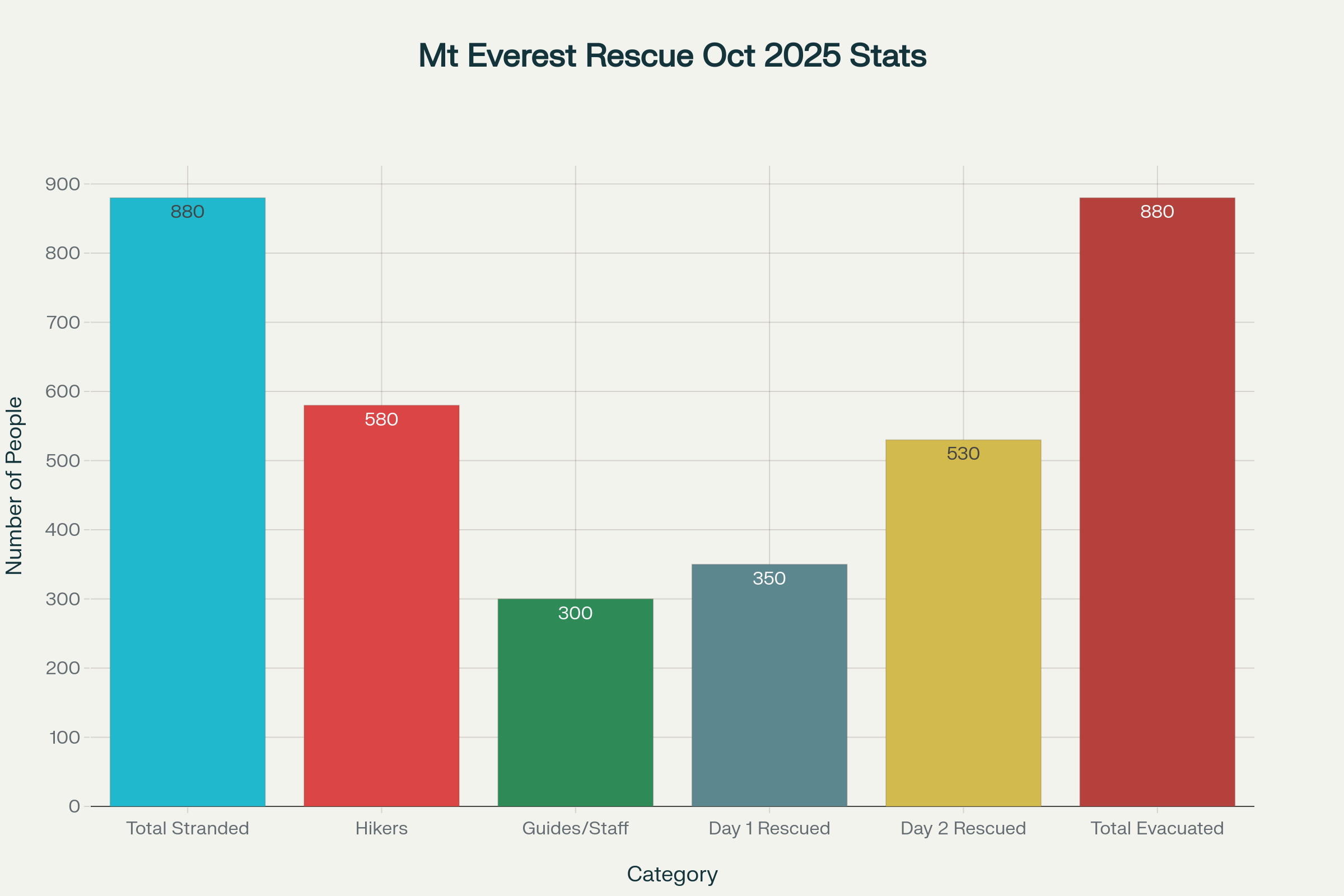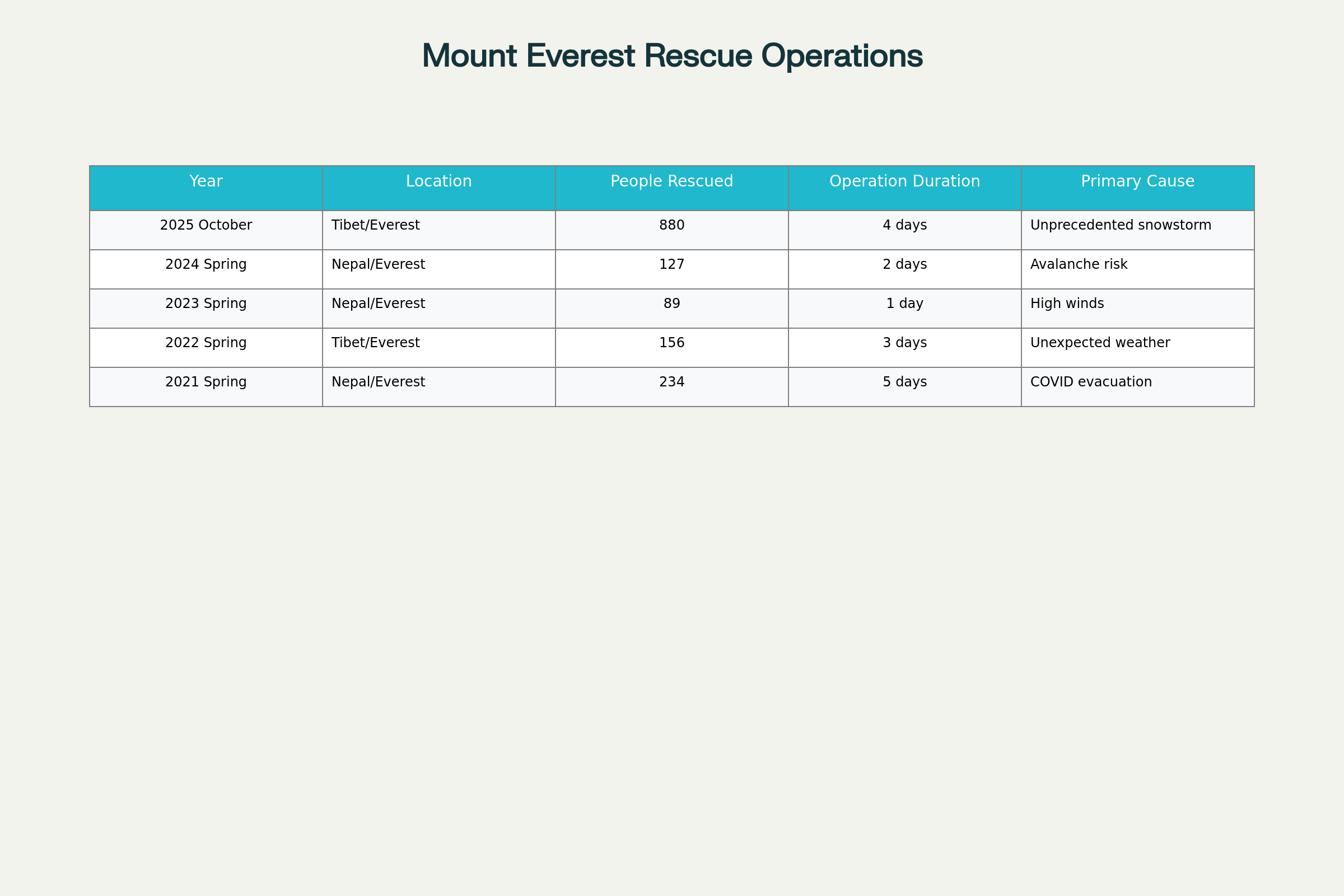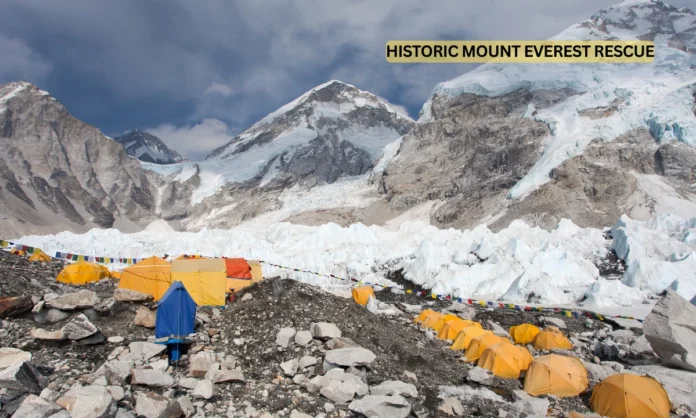Key Highlights
- Nearly 880 individuals successfully evacuated in largest Mount Everest rescue operation in regional history
- Unprecedented October snowstorm created life-threatening conditions at 16,000+ feet elevation across Tibet’s Karma Valley
- Coordinated multi-day Mount Everest rescue effort mobilized 300+ emergency personnel and local Tibetan communities
The completion of the largest Mount Everest rescue operation in recorded history has marked a significant milestone in high-altitude emergency response, with 880 stranded individuals safely evacuated following an unprecedented October blizzard. This Mount Everest rescue mission, spanning four critical days from October 5-8, 2025, demonstrated extraordinary coordination between Chinese authorities, emergency services, and local Tibetan communities across the treacherous Karma Valley region. State media confirmed that the Mount Everest rescue operation successfully evacuated 580 trekkers and over 300 guides, yak herders, and support staff who became trapped when record-breaking weather conditions struck during China’s National Day holiday period.

Statistical breakdown of the Mount Everest rescue operation showing personnel categories and evacuation timeline
Unprecedented Weather Conditions Trigger Massive Response
The Mount Everest rescue became necessary when meteorological conditions exceeded all historical precedents for the Himalayan region during early October. Climate researchers confirmed this October snowstorm deposited snow accumulation measuring 3.5 times greater than any previously recorded weather event at Mount Everest monitoring stations, creating what scientists described as “off the charts” conditions. The Mount Everest rescue teams faced extreme challenges as the blizzard dumped over three feet of snow within a 12-hour period, completely burying camping equipment and creating life-threatening hypothermia conditions.
- Snow depths reached over one meter throughout the Karma Valley, trapping trekkers in collapsed tents and makeshift shelters
- Wind speeds exceeded hurricane-force levels at elevations above 4,900 meters, creating dangerous wind chill factors during the Mount Everest rescue
- Temperatures plummeted to life-threatening levels, causing multiple confirmed cases of hypothermia among stranded individuals
- The unprecedented timing during China’s eight-day National Day holiday maximized the number of people requiring Mount Everest rescue services
Official data from China’s high-altitude weather monitoring network indicated this Mount Everest rescue situation resulted from completely abnormal October weather patterns, with snowfall intensities and duration far exceeding normal seasonal parameters for the region. The severity prompted immediate closure of all Mount Everest scenic areas and suspension of trekking permits until weather conditions normalized and Mount Everest rescue operations concluded.
Coordinated Emergency Response and Multi-Day Operations
The Mount Everest rescue mobilized over 300 specialized emergency personnel, including high-altitude rescue specialists, medical teams, and hundreds of local Tibetan villagers who provided crucial support throughout the operation. Chinese authorities coordinated this Mount Everest rescue through Tibet‘s Dingri County emergency management system, establishing multiple evacuation routes and supply stations across the affected region. Rescue teams utilized traditional methods including horses and yaks alongside modern equipment to reach stranded groups at elevations where helicopter operations remained impossible due to severe weather conditions.
- Approximately 350 individuals reached safety during the initial Mount Everest rescue phase on Monday, led by experienced local guides and emergency teams
- Mount Everest rescue teams established multiple emergency supply stations providing food, medical care, heating equipment, and oxygen supplies
- Tibet’s Blue Sky Rescue Team coordinated with government emergency services after receiving initial distress calls at 5:00 AM on October 5
- Local Tibetan communities provided essential support, with hundreds of villagers joining professional Mount Everest rescue operations using traditional knowledge and equipment
Emergency medical teams treated approximately twelve individuals for severe hypothermia, altitude sickness, and related complications during the Mount Everest rescue evacuation process, with all patients successfully stabilized and evacuated. The Mount Everest rescue demonstrated remarkable coordination across multiple countries’ nationals, including Chinese citizens, European trekkers, and international mountaineers.
Regional Impact and Comparative Analysis
Beyond the primary Mount Everest rescue operation, the October blizzard system triggered emergency responses across multiple provinces in western China’s high-altitude regions. In Qinghai Province, parallel rescue operations evacuated 137 additional stranded hikers, though one individual tragically died from hypothermia and altitude-related complications. The coordinated Mount Everest rescue highlighted China’s enhanced disaster management capabilities compared to previous emergency responses in remote mountain regions.

Comparative analysis of major Mount Everest rescue operations from 2021-2025
The scale of this Mount Everest rescue operation significantly exceeded previous high-altitude emergency responses in the Himalayan region, establishing new benchmarks for coordinated disaster response. Historical data from the Himalayan Rescue Association indicates that typical seasonal rescue operations involve 50-150 individuals, making this Mount Everest rescue nearly six times larger than standard emergency responses. Tourism statistics show over 540,000 visitors traveled to the Everest region in 2024, representing a new record that contributed to the elevated number of people requiring Mount Everest rescue services during this incident.
Enhanced Safety Protocols and Future Implications
The successful Mount Everest rescue has prompted comprehensive reviews of high-altitude tourism safety protocols and emergency preparedness systems across the Himalayan region. Mountain safety experts emphasize that this Mount Everest rescue operation demonstrated both the effectiveness of coordinated emergency response and the growing risks associated with increased tourism in extreme environments. Regional authorities have implemented enhanced weather monitoring systems and stricter permit requirements following this Mount Everest rescue to prevent similar large-scale emergency situations.
- Tourism authorities suspended all permits for the Karma Valley, Rongshar Valley, and Cho Oyu regions pending comprehensive safety assessments
- Enhanced GPS tracking systems and mandatory emergency communication devices now required for all high-altitude trekking permits
- Mount Everest rescue protocols updated to include pre-positioned emergency supplies and expanded local community training programs
- Weather forecasting systems upgraded with additional monitoring stations to provide earlier warnings for future Mount Everest rescue scenarios
The Mount Everest rescue has highlighted the critical importance of climate adaptation strategies as extreme weather events become more frequent and severe across the Himalayan mountain system, requiring continued investment in rescue infrastructure and emergency preparedness.
Final Assessment
The historic Mount Everest rescue operation represents an unprecedented achievement in high-altitude emergency response, with 880 individuals successfully evacuated despite record-breaking weather conditions and extremely challenging terrain. This Mount Everest rescue established new standards for coordination between government agencies, emergency services, and local communities in the world’s most remote mountain regions. The Mount Everest rescue operation has prompted essential discussions about enhanced safety protocols, improved weather forecasting systems, and stricter permit requirements for high-altitude tourism during unpredictable seasonal transitions.
As extreme weather patterns continue affecting the Himalayan region, the successful Mount Everest rescue provides a crucial template for future emergency response operations while underscoring the growing importance of climate adaptation and enhanced safety infrastructure in supporting the region’s vital tourism economy.


